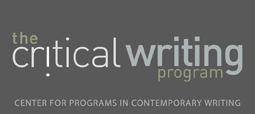Marketing
Overview of the Discipline
The American Marketing Association defines marketing as "the activity, set of institutions, and processes for creating, communicating, delivering, and exchanging offerings that have value for customers, clients, partners, and society at large." As a discipline, marketing addresses the exchange between the buyer and the seller. Marketing research links different actors and conditions in the market to the marketer through information.
Sub-disciplines of marketing include:
- Consumer Behavior
- Distribution
- Management
- Marketing Research
- Marketing Strategy
- Pricing
- Product/Brand Management
- Promotion
To learn more about marketing, please visit: American Marketing Association and The Department of Marketing at the Wharton School.
Writing in the Discipline
Goals
The scholarly approach to marketing is generally predicated upon problem definition and solution. For example, scholars might seek to define and explain the preferences of a consumer segment to inform the positioning of a product. They aim to explain and evaluate the dynamics of the marketplace, pushing incisively beyond the “noise” of the interactions between agents in the market to identify patterns and develop principles.
Some specific goals in this discipline include:
- Identifing and defining marketing opportunities and problems
- Generating, refining, and evaluating marketing actions to monitor marketing performance
- Improving the understanding of marketing as a business function
REASONING
Marketing scholars use both explanatory and justificatory reasoning. Academic writing typically employs explanatory reasoning based on qualitative and quantitative data. When scholars write for a professional or business audience, however, they are likely to use justificatory reasoning to support their strategic suggestions. One example is Dr. David Bell's article for MIT Sloan Management Review, "What Matters Most in Internet Retailing." The majority of the article focuses on an explanation of Dr. Bell's studies on the relationship between the geographic location of customers and sales diffusion of online retailers. The final piece of the article, however, provides recommendations about what executives should do to make the most of his research.
EVIDENCE
As a broad field subject to interdisciplinary influences, marketing can be viewed in terms of two large subdivisions. One half is quantitatively focused, with an evidentiary emphasis on econometrics, statistics and regression-based models. The other half is behavioral and shares characteristics with psychology and sociology. This approach largely depends on classical hypothesis testing and often involves test groups.
Evidence in marketing reflects this general division. It is characterized by a combination of laboratory (e.g. consumer testing) and field data (e.g. surveys and sales metrics). To guarantee the external validity of results, marketing scholars conduct considerable field study, especially in sub-disciplines that involve a large behavioral or psychological component.
AUTHORSHIP
Most papers in marketing are co-authored.
CLAIMS
Valid claims in marketing must be supported by a relevant theory and, if possible, data as well.
Writing Tips
Important Criteria for Student Writing
Originality of ideas (invention), reasoning and evidence, and organization are the most crucial elements of successful writing in marketing. Scholars in this field approach research and writing as a matter of what new material can be added to the existing knowledge base. Mechanical elements of writing, such as grammar and formatting, are important but secondary.
Common Errors
A common error is failure to demonstrate critical thinking. Students should strive to be analytical instead of descriptive in their assignments and aim for clarity and concision. Mechanical errors are also common, though they are more easily remedied than substantive errors.
Style
There is some debate over the appropriate voice for this field. Some scholars argue for a third-person perspective and use of the passive voice, while others argue for active voice. Regardless of the voice and perspective, students should aim for a style that is informative and concise.
Genre
Typical Student Assignments
- Research papers
- Strategic campaign/plan development
- Case reviews
- Press releases
Professional Writing
- Scholarly/journal articles
- Scholarly books
- Trade press books (written for the wider business community as opposed to the academic marketing community)
- Business case briefs
- Magazine thought pieces
Examples of Scholarly Writing
Bell, David, Corsten, Daniel, and Knox, George (2011), "From Point-of-Purchase to Path-to-Purchase: How PreShopping Factors Drive Unplanned Buying," Journal of Marketing, 75.Kahn, Barbara E., Nowlis, Stephen M., Dhar, Ravi (2002), "Coping with Ambivalence: The Effect of Removing a 'Fence Sitting' Option on Consumer Attitude and Preference Judgments," Journal of Consumer Research, 29 (3).
© 2013 The University of Pennsylvania
Meet the Professors

Dr. David Bell
Professor Bell is the Xinmei Zhang and Yongge Dai Professor of Marketing at the Wharton School. More...

Dr. Barbara E. Kahn
Professor Kahn is the Patty and Jay H. Baker Professor of Marketing and the Director of the Jay H. Baker Retailing Center at the Wharton School. More...
